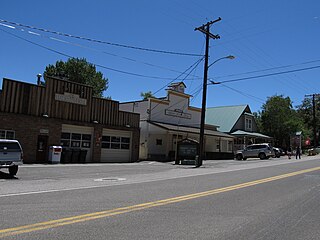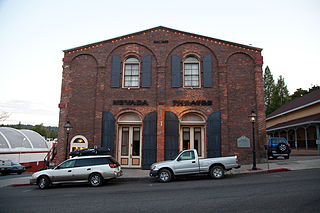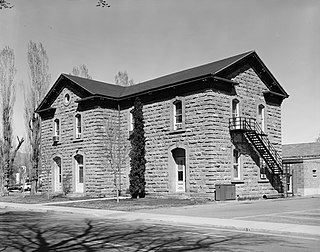
The Consolidated Municipality of Carson City is an independent city and the capital of the U.S. state of Nevada. As of the 2020 census, the population was 58,639, making it the sixth largest city in Nevada. The majority of the city's population lives in Eagle Valley, on the eastern edge of the Carson Range, a branch of the Sierra Nevada, about 30 miles (50 km) south of Reno. The city is named after the mountain man Kit Carson. The town began as a stopover for California-bound immigrants, but developed into a city with the Comstock Lode, a silver strike in the mountains to the northeast. The city has served as Nevada's capital since statehood in 1864; for much of its history it was a hub for the Virginia and Truckee Railroad, although the tracks were removed in 1950.

Virginia City is a census-designated place (CDP) that is the county seat of Storey County, Nevada, and the largest community in the county. The city is a part of the Reno–Sparks Metropolitan Statistical Area.

Genoa is an unincorporated town in Douglas County, Nevada, United States. Founded in 1851, it was the first settlement in what became the Nevada Territory. It is situated within Carson River Valley and is approximately 42 miles (68 km) south of Reno. The population was 939 at the 2010 census. It is home to the oldest bar in the state of Nevada which opened in 1853.
Frederic Joseph DeLongchamps was an American architect. He was one of Nevada's most prolific architects, yet is notable for entering the architectural profession with no extensive formal training. He has also been known as Frederick J. DeLongchamps, and was described by the latter name in an extensive review of the historic importance of his works which led to many of them being listed on the U.S. National Register of Historic Places in the 1980s.

Belmont is a ghost town in Nye County, Nevada, United States along former State Route 82. The town is a historic district listed in the National Register of Historic Places. It is Nevada Historical Marker number 138.

The Nevada State Capitol is the capitol building of the U.S. state of Nevada located in the state capital of Carson City at 101 North Carson Street. The building was constructed in the Neoclassical Italianate style between 1869 and 1871. It is listed in the National Register of Historic Places. It is also Nevada Historical Marker number 25.

U.S. Route 50 (US 50) is a transcontinental highway in the United States, stretching from West Sacramento, California, in the west to Ocean City, Maryland, on the east coast. The Nevada portion crosses the center of the state and was named "The Loneliest Road in America" by Life magazine in July 1986. The name was intended as a pejorative, but Nevada officials seized it as a marketing slogan. The name originates from large desolate areas traversed by the route, with few or no signs of civilization. The highway crosses several large desert valleys separated by numerous mountain ranges towering over the valley floors, in what is known as the Basin and Range province of the Great Basin.

Downtown Columbus is the central business district of Columbus, Ohio. Downtown is centered on the intersection of Broad and High Streets, and encompasses all of the area inside the Inner Belt. Downtown is home to most of the tallest buildings in Columbus.

The Nevada Theatre, also known as the Cedar Theatre, located in downtown Nevada City, California, is California's oldest existing theater building. Its principal periods of significance were 1850–1874, 1875–1899, 1900–1924, and 1925–1949.

The Mizpah Hotel is a historic hotel in Tonopah, Nevada, U.S. It is a member of Historic Hotels of America, the official program of the National Trust for Historic Preservation.

The Sears–Ferris House, at 311 W Third Street in Carson City, Nevada, is a historic house built in 1863. It was owned from 1868 to 1890 by George Washington Gale Ferris Sr., father of George Washington Gale Ferris Jr., future inventor of the Ferris wheel. It has also been known as the G. W. G. Ferris House.

The State Bank and Trust Company Building, more commonly known as the Belvada, is a historic bank building located at 102 Brougher Avenue in Tonopah, Nevada. The building was constructed in 1906 for the State Bank and Trust Company, a local bank founded in 1902. Architect George E. Holesworth designed the building in the Classical Revival style. Holesworth's design features granite pilasters separating the building's bays, a dentillated metil cornice with modillions along the roof, and an egg-and-dart cornice at the top of the first floor. The bank moved into the building in June 1907, but it only occupied it for four months. The bank had lent the L.M. Sullivan Trust Company, a land speculating company, a large sum, and when the company failed, the bank did as well. In 1908, the Nevada Club Saloon opened in the building; it was joined by the First National Bank of Nevada later in the year. The five-story building and the nearby Mizpah Hotel, also five stories, were the tallest buildings in the state until 1927.

The Wabuska Railroad Station, on S. Carson St. in Carson City, Nevada, was built in 1906. It was a work of the Southern Pacific Co. It was listed on the National Register of Historic Places in 1984.

The Leport–Toupin House, at 503 E. Telegraph St. in Carson City, Nevada, is a historic simplified-Second Empire-style house that was built in 1879. It was converted to a pre-school in 1969. Also known as the Hawkins House, it was listed on the National Register of Historic Places in 1985.

The King–McBride Mansion, at 26-28 S. Howard St. in Virginia City, Nevada, is a historic Italianate-style house that was built in 1876, not long after the "Great Fire" in October, 1875. Also known as King House, it was listed on the National Register of Historic Places in 1998.

The Carson Brewing Company, at 102 S. Division St. in Carson City, Nevada, was built in 1864. Also known as the Carson City Nevada Appeal Building, it was listed on the National Register of Historic Places in 1978. It was originally a brewery and bar.

The Nevada State Printing Office, at 101 S. Fall St. in Carson City, Nevada, was built in 1885–86. Also known as the Old State Printing Office, it was a work of Reno architect M.J. Curtis. It is located across from the Nevada State Capitol building. Also known as the Old State Printing Office, it was a work of two architects named Morrill J. Curtis and Seymore Pixley. It is the second oldest State-built structure in the Capitol Complex.

The Foreman–Roberts House, formerly the James D. Roberts House and now also known as the Foreman–Roberts House Museum, is a historic house and museum located at 1217 N. Carson St. in Carson City, Nevada. The house was built in 1859 and was moved to the present location in 1873. Known also as the Thurman Roberts House for the last member of the Roberts family, it is listed on the National Register of Historic Places. It is the headquarters of the Carson City Historical Society and is open to the public by appointment and for special events.

The St. Charles-Muller's Hotel, at 302-304-310 S. Carson St. in Carson City, Nevada, is a historic hotel built in 1862. It has also been known as the St. Charles Hotel and as the Pony Express Hotel. It includes vernacular Italianate architecture.

The Old Winters Ranch/Winters Mansion, near Carson City, Nevada, was completed in 1864. Also known as Rancho del Sierra, it was listed on the National Register of Historic Places in 1974. It was argued to be significant for its historical associations, for its architecture, and for its "continuing educational possibilities."





















